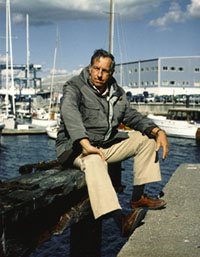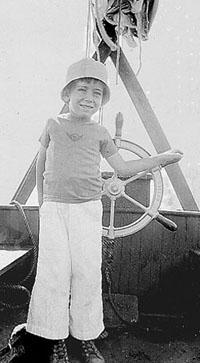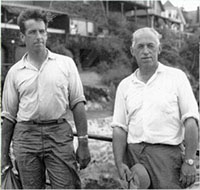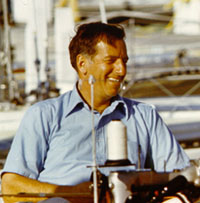From TedHood.com... Frederick E. "Ted" Hood 1927-2013 | ||||||||
In 1955, he founded Hood Sailmakers in the back of Maddie's Bar in Marblehead, but later moved the operation to the nearby Little Harbor section of that town. With his father's help, Ted was the first sail maker to weave his own sailcloth, revolutionizing the process to enhance the strength and durability of his sails. By the 1970s, Hood Sailmakers had grown into a worldwide network of service and production lofts, with his sails ubiquitous on winning yachts including all the Americas Cup winners from 1958 to 1977.
Combining a natural sailing ability with his aptitude for design, Ted built and skippered a successful series of keel and centerboard racing yachts under the name Robin. In 1959 his career took off when he won the New York Yacht Club Annual Cruise in his first Robin. He did so, not only as skipper, but as designer, builder and sail maker. In 1962 and 1964 he repeated the feat with Nefertiti in the America’s Cup trials.
Three years later he campaigned Independence, the second 12-Meter he designed, against Courageous, which he had redesigned, but was ultimately runner up in the defender trials. By the early 1980's Ted had turned his attention away from sail making and to boat building and design. He created a line of sailboats under the "Little Harbor" name, and constructed many yachts under that name from 38’ to 78’, personally involved with design and construction details. In addition, various builders worldwide built over 1,500 yachts of his design, including the 133’ Anakena.
After selling his business in 1999, Ted continued to work on new yacht designs, including both power and sail catamarans and expedition yachts. In 2006 Ted wrote his autobiography “Ted Hood, Through Hand and Eye”, with Michael Levitt. Ted was a member of the Corinthian, Eastern and Boston Yacht Clubs in Marblehead, the New York Yacht Club, the Cruising Club of America, Storm Trysail Club and Blue Water Sailing Club. He was named Yachtsman of the Year in 1974, was elected to the America’s Cup Hall of Fame and the National Sailing Hall of Fame. According to his children, he was marking up drawings right into his last days. All who knew him were inspired by his innovative mind, entrepreneurial spirit and creative passion. |
First Harbor Company
Sunday, October 16, 2016
10.16.16 Ted Hood
Sunday, September 25, 2016
9.25.16 Floyd Irerson House
Floyd Ireson House Circle Street
From Wikipedia...
Benjamin "Flood" Ireson (c.1775 – after 1808) was a 19th-century American sailor, captain of the schooner Betsy. In 1808, during a gale, the Betsy was on its way from Grand Banks to home port when it discovered another ship, the Active. The Active was wrecked and taking on water.[1]
"Ireson tried to rescue the crew of the sinking vessel, but his own men insisted upon giving up an attempt which held considerable dangers. On return to Marblehead, the crew, finding themselves blamed for the loss of life, placed responsibility upon their captain."[2] The people of Marblehead, the Betsy's home port, were outraged with Ireson, and he was tarred and featheredand dragged out of town in a cart.
John Greenleaf Whittier first heard the tale in 1823,[3] and wrote a poem based on the incident, Skipper Ireson's Ride.
There was some question as to the identity of the person. In later retellings, it was "Floyd" Ireson who was punished. A series of letters in the Boston Evening Transcript in 1837 identified "Floyd" Ireson as Benjamin "Flood" Ireson. In retellings, his nickname, Flood, had become corrupted to Floyd.[4]
"The inhabitants of Marblehead eventually recognized their mistake, but Whittier's poem served to perpetuate the original story."[2]
Skipper Ireson’s Ride
Related Poem Content Details
Of all the rides since the birth of time,
Told in story or sung in rhyme, —
On Apuleius’s Golden Ass,
Or one-eyed Calender’s horse of brass,
Witch astride of a human back,
Islam’s prophet on Al-Borák, —
The strangest ride that ever was sped
Was Ireson’s, out from Marblehead!
Old Floyd Ireson, for his hard heart,
Tarred and feathered and carried in a cart
By the women of Marblehead!
Body of turkey, head of owl,
Wings a-droop like a rained-on fowl,
Feathered and ruffled in every part,
Skipper Ireson stood in the cart.
Scores of women, old and young,
Strong of muscle, and glib of tongue,
Pushed and pulled up the rocky lane,
Shouting and singing the shrill refrain:
“Here ’s Flud Oirson, fur his horrd horrt,
Torr’d an’ futherr’d an’ corr’d in a corrt
By the women o’ Morble’ead!”
Wrinkled scolds with hands on hips,
Girls in bloom of cheek and lips,
Wild-eyed, free-limbed, such as chase
Bacchus round some antique vase,
Brief of skirt, with ankles bare,
Loose of kerchief and loose of hair,
With conch-shells blowing and fish-horns’ twang,
Over and over the Mænads sang:
“Here ’s Flud Oirson, fur his horrd horrt,
Torr’d an’ futherr’d an’ corr’d in a corrt
By the women o’ Morble’ead!”
Small pity for him! — He sailed away
From a leaking ship in Chaleur Bay, —
Sailed away from a sinking wreck,
With his own town’s-people on her deck!
“Lay by! lay by!” they called to him.
Back he answered, “Sink or swim!
Brag of your catch of fish again!”
And off he sailed through the fog and rain!
Old Floyd Ireson, for his hard heart,
Tarred and feathered and carried in a cart
By the women of Marblehead!
Fathoms deep in dark Chaleur
That wreck shall lie forevermore.
Mother and sister, wife and maid,
Looked from the rocks of Marblehead
Over the moaning and rainy sea, —
Looked for the coming that might not be!
What did the winds and the sea-birds say
Of the cruel captain who sailed away? —
Old Floyd Ireson, for his hard heart,
Tarred and feathered and carried in a cart
By the women of Marblehead!
Through the street, on either side,
Up flew windows, doors swung wide;
Sharp-tongued spinsters, old wives gray,
Treble lent the fish-horn’s bray.
Sea-worn grandsires, cripple-bound,
Hulks of old sailors run aground,
Shook head, and fist, and hat, and cane,
And cracked with curses the hoarse refrain:
“Here’s Flud Oirson, fur his horrd horrt,
Torr’d an’ futherr’d an’ corr’d in a corrt
By the women o’ Morble’ead!”
Sweetly along the Salem road
Bloom of orchard and lilac showed.
Little the wicked skipper knew
Of the fields so green and the sky so blue.
Riding there in his sorry trim,
Like an Indian idol glum and grim,
Scarcely he seemed the sound to hear
Of voices shouting, far and near:
“Here’s Flud Oirson, fur his horrd horrt,
Torr’d an’ futherr’d an’ corr’d in a corrt
By the women o’ Morble’ead!”
“Hear me, neighbors!” at last he cried, —
“What to me is this noisy ride?
What is the shame that clothes the skin
To the nameless horror that lives within?
Waking or sleeping, I see a wreck,
And hear a cry from a reeling deck!
Hate me and curse me, — I only dread
The hand of God and the face of the dead!”
Said old Floyd Ireson, for his hard heart,
Tarred and feathered and carried in a cart
By the women of Marblehead!
Then the wife of the skipper lost at sea
Said, “God has touched him! why should we!”
Said an old wife mourning her only son,
“Cut the rogue’s tether and let him run!”
So with soft relentings and rude excuse,
Half scorn, half pity, they cut him loose,
And gave him a cloak to hide him in,
And left him alone with his shame and sin.
Poor Floyd Ireson, for his hard heart,
Tarred and feathered and carried in a cart
By the women of Marblehead!
Sunday, September 18, 2016
9.18.16 Sea Sled
Sea Sled designed by Albert Hickman and built at Graves Yacht Yard Marblehead
Photo taken sometime during WW2 showing the sea sled at the float
in Barnegat Browns Island in the background.
Sunday, August 7, 2016
Sunday, July 10, 2016
7.10.16 Halcyon&Henry Morss
Halcyon built for Henry Morss 1913 by Stearns and MacKay
Seen here being taken out of the paint shop at the yard on
Front St. Marblehead prior to launching.
The Henry A. Morss Memorial Trophy
The Henry A. Morss Memorial Trophy is awarded to the winning team in the ICSA/Gill Coed Dinghy National Championship. The trophy was donated by a group of nationally known yachtsmen as a memorial to Henry A. Morss, a Boston yachtsman and 1907 Bermuda Race winner, as well as an MIT alumnus and benefactor.
The National Dinghy Championship was inaugurated in 1937, with a group of prominent yachtsmen donating the Henry A. Morss Memorial Trophy to the Inter-Collegiate Y.R.A. as a perpetual trophy in memory of a yachtsman and former MIT official who helped make possible college dinghy racing. The donors include Charles Francis Adams, Nathaniel F. Ayer, Edwin A. Boardman, Charles P. Curtis, Chandler Hovey, and Gerald B. Lambert. The Morss Trophy, which is the most coveted and important of all inter-collegiate dinghy trophies, is a simple but beautiful bowl of the Paul Revere type on which the names of the winning colleges and crews are engraved. The early competitions were sailed at MIT on the Charles River, but since 1946 the site has been rotated throughout the member districts of the Intercollegiate Yacht Racing Association.
Henry Morss house Harbor Ave. Marblehead Neck
ca. 1919
Henry Morss also owned the schooner yacht "Dervish" which won the
New York to Bermuda race in 1907.
Henry Morss at the wheel of "Dervish"
"Dervish" Hamilton Bermuda Harbor 1907
Sunday, June 12, 2016
Sunday, June 5, 2016
Subscribe to:
Comments (Atom)




















